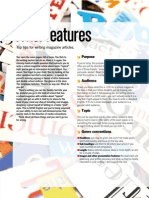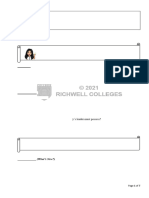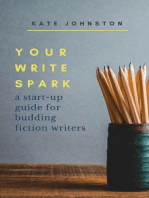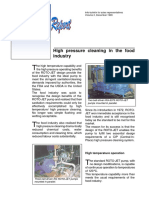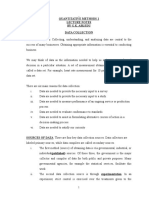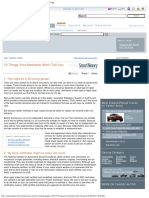Brainstorming and Free Writing: "Genius Is One Percent Inspiration and Ninety-Nine Percent Perspiration." Thomas Edison
Brainstorming and Free Writing: "Genius Is One Percent Inspiration and Ninety-Nine Percent Perspiration." Thomas Edison
Uploaded by
وردة بيضاءCopyright:
Available Formats
Brainstorming and Free Writing: "Genius Is One Percent Inspiration and Ninety-Nine Percent Perspiration." Thomas Edison
Brainstorming and Free Writing: "Genius Is One Percent Inspiration and Ninety-Nine Percent Perspiration." Thomas Edison
Uploaded by
وردة بيضاءOriginal Description:
Original Title
Copyright
Available Formats
Share this document
Did you find this document useful?
Is this content inappropriate?
Copyright:
Available Formats
Brainstorming and Free Writing: "Genius Is One Percent Inspiration and Ninety-Nine Percent Perspiration." Thomas Edison
Brainstorming and Free Writing: "Genius Is One Percent Inspiration and Ninety-Nine Percent Perspiration." Thomas Edison
Uploaded by
وردة بيضاءCopyright:
Available Formats
BRAINSTORMING AND FREE WRITING
“Genius is one percent inspiration and ninety-nine percent perspiration.”
Thomas Edison
Often times when you begin the process of writing a paper, you feel totally devoid of inspiration and
simply do not know where to begin. Finding a topic or main argument for a paper is a difficult task
for many writers, but one of the best ways to help you get started is to brainstorm.
Brainstorming is the process of coming up with ideas. You can brainstorm in order to decide on a
topic, to explore approaches to your paper, or to deepen your understanding of a certain subject.
Finding a brainstorming technique that works for you can greatly improve your writing efficiency.
There are myriad brainstorming techniques to choose from. Take some time to try out several of
these techniques and find one that suits your learning style:
q Key Word Clustering/Mapping:
Write down key words or phrases relevant to your topic of interest. Draw lines to
identify connections between them.
q Listing:
Make a list of ideas and/or quotations about your potential topic. For each idea or
quotation, write a question you would like your paper to answer, according to your
interests.
q Asking Questions:
Write down every question you have about your topic. Circle the ones you want to
address in your paper.
q Making a Recipe:
Write a recipe that lists all of the ingredients or basic ideas of your paper.
q Writing Dialogue:
Write a dialogue where person A agrees with your point of view and person B disagrees.
Try to be objective.
q Writing Letters:
Write a letter to someone explaining why you agree or disagree with a particular point.
Write another letter taking the other side. Write a letter to the author of the text you are
working with. What questions do you have about the text?
q Free Writing:
Write without stopping for a set amount of time, using one idea as your springboard. See
reverse of this handout for further information about free writing.
Consultants in the Naropa Writing Center can give you explanations that are more detailed, engage
in these activities with you, or dialogue with you about your results so you can move to the next
phase of writing.
NAROPA WRITING CENTER: MONDAY–THURSDAY 10–6; FRIDAY 10–2
BRAINSTORMING AND FREE WRITING
Another effective way to jumpstart a writing assignment, whether you are just beginning or already
mired down in revision, is to do a free write.
Free writing is an exercise in which you write without stopping for a set period of time with no
consideration of grammar, punctuation, spelling, or even logical progression. The purpose of a free
write is to rely on your subconscious to make associations and to keep your pen moving without
editing each word or thought before it hits the page. This can be very useful in helping you put ideas
down that you might not have previously considered.
The following are some guidelines for a successful free write:
q Set a time limit between five and thirty minutes, and try to stick to it—don’t stop early or
continue too long.
q Allow yourself to continue writing regardless of what your “inner critic” might say (or
what your professor, parents, or best friend might say if s/he read what you were
writing). Write fearlessly. This free write is for your eyes only.
q Don’t stop for grammar, spelling, or word choice. In a free write, your first thought is
your best thought.
q If you get stuck, don’t stop writing. It may sound silly, but keep your hand moving at all
times, even if that means rewriting the last word you came up with over and over again
until something else comes to mind.
q Other key phrases to write your way out of being stuck include:
· I remember…
· I forget…
· I hate…
· I love…
· This book is about…
· This book is not about…
· I just want to say…
q When the time is up, look over your writing and highlight ideas that you feel are
important, meaningful, or thought provoking. You can take these ideas and do another
free write or perhaps begin some preliminary research.
NAROPA WRITING CENTER: MONDAY–THURSDAY 10–6; FRIDAY 10–2 2
You might also like
- Manual de Inspección de PuentesDocument300 pagesManual de Inspección de PuentesOswaldo Zavala100% (2)
- 101 Creative Writing Exercises (Adventures in Writing)From Everand101 Creative Writing Exercises (Adventures in Writing)Rating: 4 out of 5 stars4/5 (10)
- Planetary Aspects in KPDocument4 pagesPlanetary Aspects in KPKrishna CHNo ratings yet
- Apostles The Fathering ServantDocument20 pagesApostles The Fathering ServantJose Humberto Zumarraga Novelo100% (3)
- Ethics Utilitarian and Kantian Ethics and WarDocument3 pagesEthics Utilitarian and Kantian Ethics and Warapi-3729409100% (3)
- Using Pre-Writing StrategiesDocument18 pagesUsing Pre-Writing StrategiesrotimasronelioNo ratings yet
- Free English LessonsDocument19 pagesFree English LessonsRaiAyuSaraswatiNo ratings yet
- Brain StormingDocument3 pagesBrain Stormingmandukhai tsogtsaikhanNo ratings yet
- Fill The Gaps Exercise ThijsDocument7 pagesFill The Gaps Exercise Thijsnicole_952No ratings yet
- Ss 5Document2 pagesSs 5api-3816734No ratings yet
- 13 Justificatory Outline InstructionsDocument4 pages13 Justificatory Outline InstructionsfiahstoneNo ratings yet
- The Writing Process: Five Basic StagesDocument10 pagesThe Writing Process: Five Basic Stagesmelodie03100% (2)
- Preparing and Writing A Dissertation: A Model To Criticise!Document6 pagesPreparing and Writing A Dissertation: A Model To Criticise!0599709108No ratings yet
- Freewriting Skills IIT BhubaneswarDocument8 pagesFreewriting Skills IIT BhubaneswarBibhukalyan NayakNo ratings yet
- How To Brainstorm When Writing An Essay: Previous Post Next PostDocument9 pagesHow To Brainstorm When Writing An Essay: Previous Post Next PostAbdul Nisar JilaniNo ratings yet
- Generating Ideas & Topics For Writing: Revised August 2013Document1 pageGenerating Ideas & Topics For Writing: Revised August 2013MarianNo ratings yet
- Methods of Research-7Document14 pagesMethods of Research-7Moustafa AbdullahNo ratings yet
- Stop Stalling and Write: Ten Tips to Help You Focus, Write and SucceedFrom EverandStop Stalling and Write: Ten Tips to Help You Focus, Write and SucceedNo ratings yet
- Write Your Book in Three DraftsDocument31 pagesWrite Your Book in Three Draftskatiaferes100% (2)
- Class 10 - The Writing ProcessDocument3 pagesClass 10 - The Writing ProcessIbadullah RashdiNo ratings yet
- How To Write A Nonfiction Book in 6 StepsDocument10 pagesHow To Write A Nonfiction Book in 6 StepsYuheNo ratings yet
- Symptoms and Cures For WriterDocument4 pagesSymptoms and Cures For WriterSoulouphou NyTokiana RavelojaonaNo ratings yet
- Writing GuidelinesDocument11 pagesWriting GuidelinesChrissyNo ratings yet
- Confident Writing: 20 Fun Exercises To Help You To Write Easily And WellFrom EverandConfident Writing: 20 Fun Exercises To Help You To Write Easily And WellNo ratings yet
- 76 Tips To Overcome Writer's BlockDocument6 pages76 Tips To Overcome Writer's Blockmanishkul-100% (1)
- The Pre-Writing Process:: by Tarasine A. BuckDocument33 pagesThe Pre-Writing Process:: by Tarasine A. Buckefendi odid100% (2)
- How To BrainstormDocument6 pagesHow To BrainstormMrKeelerNo ratings yet
- Fitter Features: Top Tips For Writing Magazine Articles. PurposeDocument2 pagesFitter Features: Top Tips For Writing Magazine Articles. PurposeChesterine CopperfieldNo ratings yet
- Prewriting StrategiesDocument10 pagesPrewriting Strategiesshreya0792No ratings yet
- Simple Way To Write A Thesis StatementDocument6 pagesSimple Way To Write A Thesis Statementjillcrawfordbaltimore100% (2)
- Prewriting: By: Muneeb Ullah ShahDocument8 pagesPrewriting: By: Muneeb Ullah ShahMuneeb ullah ShahNo ratings yet
- Read The Essay Contest Rules: 200 Bananas Made A Woman Queen For A DayDocument6 pagesRead The Essay Contest Rules: 200 Bananas Made A Woman Queen For A DayjamwafuNo ratings yet
- Course Work ElpDocument31 pagesCourse Work ElpMuhammad NazrinNo ratings yet
- Pre Writing For English 10Document22 pagesPre Writing For English 10Jesha Lou Viscara PatricioNo ratings yet
- Eapp - Lesson 6Document7 pagesEapp - Lesson 6Elysa Seyer CamilleNo ratings yet
- How Do You Write A Great Thesis StatementDocument5 pagesHow Do You Write A Great Thesis Statementkristinacamachoreno100% (2)
- How To Write A Descriptive EssayDocument3 pagesHow To Write A Descriptive EssayShantalle MinNo ratings yet
- I Need Help Writing A Thesis StatementDocument7 pagesI Need Help Writing A Thesis Statementotmxmjhld100% (2)
- Effective Writing: Learning The Skills To Write Quality PapersDocument21 pagesEffective Writing: Learning The Skills To Write Quality Paperstarabparker1No ratings yet
- Introduction To Journal-Style Scientific WritingDocument9 pagesIntroduction To Journal-Style Scientific WritingThulasi BrindhaNo ratings yet
- Nail Your Novel: Draft, Fix & Finish With Confidence. A Companion WorkbookFrom EverandNail Your Novel: Draft, Fix & Finish With Confidence. A Companion WorkbookRating: 3 out of 5 stars3/5 (1)
- How To Create An Effective Thesis StatementDocument8 pagesHow To Create An Effective Thesis Statementfjgjdhzd100% (2)
- Week by Week: A Year's Worth of Journaling Prompts & Meditations: Journaling for Transformation, #1From EverandWeek by Week: A Year's Worth of Journaling Prompts & Meditations: Journaling for Transformation, #1Rating: 4 out of 5 stars4/5 (3)
- Example Thesis Statement Personal NarrativeDocument5 pagesExample Thesis Statement Personal Narrativemeganfosteromaha100% (2)
- 13 Prewriting Techniques PDFDocument35 pages13 Prewriting Techniques PDFMalik Usman AhmadNo ratings yet
- Roadmapping Your Thought Leadership Book: Rapid Writing SeriesFrom EverandRoadmapping Your Thought Leadership Book: Rapid Writing SeriesNo ratings yet
- Process of WritingDocument19 pagesProcess of WritingMohd ShabirNo ratings yet
- Ideas GenerationDocument19 pagesIdeas Generationrixxy7786No ratings yet
- StartingDocument2 pagesStartingMuhammad Yusuf PilliangNo ratings yet
- How To Be A Good Writer PDFDocument2 pagesHow To Be A Good Writer PDFchotrun100% (2)
- Format of Persuasive Essay: Write My PaperDocument3 pagesFormat of Persuasive Essay: Write My PaperLiamHillNo ratings yet
- 4 Writing Steps in A Writing ActivityDocument7 pages4 Writing Steps in A Writing ActivityDaria MizzaNo ratings yet
- How To Write An Effective Hook For A Research PaperDocument8 pagesHow To Write An Effective Hook For A Research Paperwpuzxcbkf100% (1)
- In Class Writing ExercisesDocument7 pagesIn Class Writing ExercisesKatieSalsburyNo ratings yet
- 7 Golden Rules To Write Brilliant Summaries & Essays in English - To Get The Best MarkDocument13 pages7 Golden Rules To Write Brilliant Summaries & Essays in English - To Get The Best Markvioleta2ruanoNo ratings yet
- Creative Writing Week 2Document12 pagesCreative Writing Week 2Lc MarqzNo ratings yet
- Brahma Sutra CatusutriDocument435 pagesBrahma Sutra CatusutriSathasivam GovindasamyNo ratings yet
- IPL 1 STUDENTS (Responses) PDFDocument1 pageIPL 1 STUDENTS (Responses) PDFMadhu BabuNo ratings yet
- High Pressure Cleaning in The Food Industry: Two Belt-Driven RG-S375 ROTO-JET Pumps Mounted in ParallelDocument2 pagesHigh Pressure Cleaning in The Food Industry: Two Belt-Driven RG-S375 ROTO-JET Pumps Mounted in Parallel전아진No ratings yet
- June Accounting QuestionsDocument6 pagesJune Accounting QuestionsallhomeworktutorsNo ratings yet
- Talmakkies Case Judgment Over Magistrate 21.11.2023Document17 pagesTalmakkies Case Judgment Over Magistrate 21.11.2023Krash KingNo ratings yet
- Ajis 2018 0003Document20 pagesAjis 2018 0003Tasya Fara99No ratings yet
- NotesDocument5 pagesNotesKorrine FloresNo ratings yet
- Manifiesto de La Biblioteca Pública de La IFLA/UNESCO 2022: Una Herramienta Poderosa para La Defensa de Las BibliotecasDocument4 pagesManifiesto de La Biblioteca Pública de La IFLA/UNESCO 2022: Una Herramienta Poderosa para La Defensa de Las BibliotecasR͒o͒s͒a͒ Facio AstocondorNo ratings yet
- Corporate Sales Account Executive in CO Resume Aaron SmithDocument2 pagesCorporate Sales Account Executive in CO Resume Aaron SmithAaronSmith2No ratings yet
- Roland Factory ResetDocument10 pagesRoland Factory ResetMiguel ReyesNo ratings yet
- Sample Question Paper: General Knowledge and Current AffairsDocument4 pagesSample Question Paper: General Knowledge and Current Affairsshano chaudharyNo ratings yet
- Mba ZG515 - CP - Course HandoutDocument10 pagesMba ZG515 - CP - Course HandoutudayakumargNo ratings yet
- Blind Spots - The Roots of Unethical BehaviourDocument5 pagesBlind Spots - The Roots of Unethical BehaviourMarta AntoninaNo ratings yet
- Learning Plan: Analogy To Show Relationships of WordsDocument2 pagesLearning Plan: Analogy To Show Relationships of WordsMonaliza PawilanNo ratings yet
- Lecture Notes Quanti 1Document105 pagesLecture Notes Quanti 1Godfred AbleduNo ratings yet
- High Flow Nasal Oxygen PDFDocument26 pagesHigh Flow Nasal Oxygen PDFGulshan kumarNo ratings yet
- How Far Is 7.5 On The Beep Test in KM - Google SearchDocument2 pagesHow Far Is 7.5 On The Beep Test in KM - Google SearchRakhmat Ari WibowoNo ratings yet
- ConstractivismDocument30 pagesConstractivismRaiyan SyedNo ratings yet
- Lesson Plan M5Document34 pagesLesson Plan M5Rhea CadungoNo ratings yet
- 10 Things Your Mechanic Won't Tell You - Yahoo! Autos Article PageDocument4 pages10 Things Your Mechanic Won't Tell You - Yahoo! Autos Article PageAusNo ratings yet
- "Financial Statement Analysis and Financial Forecasting AT Kec International LTD" NagpurDocument7 pages"Financial Statement Analysis and Financial Forecasting AT Kec International LTD" NagpurAnonymous g7uPednI100% (1)
- Lesson Plan PSPDocument3 pagesLesson Plan PSPDivyesh DivakarNo ratings yet
- Mapeh AssessmentDocument116 pagesMapeh AssessmentLeoncio Lumaban90% (10)
- w93c26 PDF EngDocument20 pagesw93c26 PDF EngParalela 91 DigitalNo ratings yet
- Mongols Mini DBQDocument4 pagesMongols Mini DBQasdasiodasodNo ratings yet
- TC4013Document3 pagesTC4013J. AguilarNo ratings yet





























